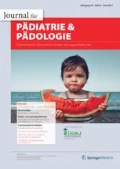Zusammenfassung
Die Behandlungserfolge bei Kindern und Jugendlichen mit Krebserkrankungen gehören zu den größten Erfolgen der Medizin der letzten Jahrzehnte. Beispielhaft stellt sich der Fortschritt bei der häufigsten Erkrankung, der akuten lymphoblastischen Leukämie (ALL) dar. Seit den 50er-Jahren des 20. Jahrhunderts führte eine sukzessive Weiterentwicklung der medikamentösen Behandlung zu einer Heilungsrate von 90 %. Es war zunächst der Beweis der Wirksamkeit der medikamentösen, potenziell stark beeinträchtigenden Therapie zu erbringen. Die Seltenheit der Erkrankungen und die Notwendigkeit, in wissenschaftlicher Weise Wirksamkeit und Behandlungsrisiken zu erfassen, waren Grundlagen für multizentrische kooperative Therapiestudien. Parallel dazu ermöglichte die Laborforschung eine zunehmende Verfeinerung der Diagnostik und lieferte wesentliche Erkenntnisse in der Krebsforschung. Klinische Studien, die in wissenschaftlicher Weise prospektiv geplant, multizentrisch durchgeführt und exakt dokumentiert wurden, belegten die Wertigkeit zunehmend komplexer einheitlicher Therapieschemata. In Österreich stellte der Zusammenschluss von 3 Zentren in die Krepler-Mutz-Kurz(KMK)-Studien den Beginn dar. Anfang der 80er-Jahre führte Helmut Gadner das in der Behandlung der ALL erfolgreiche Berlin-Frankfurt-Münster(BFM)-Schema in Österreich ein. Schließlich wurden für alle häufigen Krebsdiagnosen diagnosespezifische Therapieprotokolle generiert. Die österreichweiten Zusammenschlüsse hatten hohen informellen Charakter, waren äußerst effizient und führten zu Spitzenergebnissen in Bezug auf die Heilbarkeit im europäischen Vergleich. Gefährdet ist dieser Erfolg durch eine zunehmende Verrechtlichung der Studienlandschaft und durch einen zunehmenden ökonomischen Druck, dem Spitäler ausgesetzt sind. Die herausragenden Erfolge der pädiatrischen Onkologie in Österreich sind der engen Kooperation zwischen hervorragend funktionierenden Spitalseinheiten und dem Ineinandergreifen von Patientenversorgung und Wissenschaft zu verdanken.
Abstract
The treatment outcomes in children and young people with cancer are among the greatest successes in medicine of the last few decades. One example is the progress made in the most frequent form of the disease, acute lymphoblastic leukemia (ALL). Since the 1950s successive developments in drug treatments have led to a cure rate of 90%. Initially, this provided proof of the effectiveness of potentially highly debilitating medical treatment. The rareness of the diseases and the necessity of recording effectiveness and treatment risks scientifically were the basic principles of multicentric collaborative treatment studies. Parallel to this, laboratory research enabled the increasing refinement of the diagnosis and provided significant insights in cancer research. Clinical studies that were prospectively planned, carried out in multiple centers and precisely documented in a scientific manner proved the value of increasingly more complex standard treatment regimes. In Austria, the collaboration of three centers in the Krepler–Mutz–Kurz (KMK) studies was just the start. At last, diagnosis-specific treatment protocols were generated for all common cancer diagnoses. The collaborations throughout Austria were of a highly informal nature, were extremely efficient, and led to top curability results compared with the rest of Europe. This success is being endangered by the increasing juridification of the academic world and by the increasing economic pressure to which hospitals are subjected. The outstanding successes of pediatric oncology in Austria are down to the close cooperation between superbly functioning hospital units and patient health care meshed with science.


Literatur
Farber S, Diamond LK (1948) Temporary remissions in acute leukemia in children produced by folic acid antagonist, 4-aminopteroyl-glutamic acid. N Engl J Med 238(23):787–793
Burchenal JH, Murphy ML et al (1953) Clinical evaluation of a new antimetabolite, 6-mercaptopurine, in the treatment of leukemia and allied diseases. Blood 8(11):965–999
Frei E, Freireich E et al (1961) Studies of sequential and combination antimetabolite therapy in acute leukemia: 6-mercaptopurine and methotrexate. Blood 18:431–454
Aur RJ, Simone J et al (1971) Central nervous system therapy and combination chemotherapy of childhood lymphocytic leukemia. Blood 37:272–281
Riehm H, Gadner H, Welte K (1977) The West-Berlin therapy study of acute lymphoblastic leukemia in childhood-report after 6 years. Klin Padiatr 189:89–102
Gadner H (2013) The life and work of professor Riehm from a participant’s perspective. Klin Pädiatr 225(1):S3–4
Lüders H, Rühl U, Marciniak H, Haerting J, Claviez A, Mann G, Schellong G, Wickmann L, Dörffel W (2014) The impact of central review and central therapy planning on the treatment of children and adolescents with Hodgkin lymphoma. Eur J Cancer 50:425–433
Gatta G, Botta L et al (2014) EUROCARE Working Group. Childhood cancer survival in Europe 1999-2007: results of EUROCARE-5 – a population-based study. Lancet Oncol 15:35–47
Freireich EJ, Wiernik PH et al (2014) The leukemias: a half-century of discovery. J Clin Oncol 32:3463–3469
Hudson MM, Link MP, Simone JV (2014) Milestones in the curability of pediatric cancers. J Clin Oncol 32:2391–2397
Author information
Authors and Affiliations
Corresponding author
Ethics declarations
Interessenkonflikt
G. Mann gibt an, dass kein Interessenkonflikt besteht.
Dieser Beitrag beinhaltet keine Studien an Menschen oder Tieren.
Rights and permissions
About this article
Cite this article
Mann, G. Österreichische Kinderonkologie. Paediatr. Paedolog. Austria 50 (Suppl 2), 94–97 (2015). https://doi.org/10.1007/s00608-015-0284-1
Published:
Issue Date:
DOI: https://doi.org/10.1007/s00608-015-0284-1

